The World Economic Forum launched the Future of Jobs Report in the last quarter of 2020. The purpose of this report is to map the jobs and skills of the future. It aims to shed light on the pandemic-related disruptions in 2020, contextualized within a longer history of economic cycles and the expected outlook for technology adoption, jobs, and skills in the next five years.
With the CareHer team, we thought it would be relevant to share the key findings and some insights about the skills that women will need for the future of work.
去年年底,世界經濟論壇發布了《未來工作報告》(the Future of Jobs Report),這份報告的目的是描繪出未來的工作和技能,主要說明在了解經濟循環的背景歷史,以及未來五年科技、工作與技能的前景之下, 2020 年疫情所帶來的巨大改變。
在接下來的文章中,我們將與 CAREhER 讀者分享報告中有關於女性未來工作的重要發現與洞見。
WEF – Future of Jobs Reports – Key Findings
In the current context, with the world changing fast as it is, it looks like a difficult task to predict the future, especially the future of jobs. The impact of the COVID-19 crisis on employment has been much worse than expected initially. The International Labor Organisation said that the pandemic has disproportionately affected women workers – with a risk of losing some of the progress made on gender equality in recent decades.
What are the top findings regarding the future of jobs and how women should be prepared for that?
世界經濟論壇 -《未來工作報告》 – 重要發現
在當前環境下,世界變化地快速讓人難以預測未來,尤其是未來的工作樣貌也變得難以預料。 COVID-19 危機對於就業的影響比最初預期的還要嚴重得多。國際勞工組織 (The International Labor Organisation) 表示,疫情對於女性工作者的影響極大,有可能消彌了近幾十年來在性別平等方面的進步。
關於未來的工作樣貌,最重要的發現是什麼?女性又應該如何做好準備呢?
《Extract from imf.org》
1. The workforce is automating faster than expected, displacing 85 million jobs in the next five years. Automation, in tandem with the COVID-19 recession, is creating a “double-disruption” scenario for workers. Companies’ adoption of technology will transform tasks, jobs, and skills by 2025. Some 43 percent of businesses surveyed indicate that they are set to reduce their workforce because of technology integration, 41 percent plan to expand their use of contractors for task-specialized work, and 34 percent plan to expand their workforce as a result of technology integration. Five years from now, employers will divide work between humans and machines roughly equally.
《節錄自 國際貨幣基金組織 (International Monetary Fund, IMF)》
1. 勞動力的自動化速度快於預期,將 2025 年前,替換 8500 萬個工作職位。 自動化與COVID-19對經濟帶來的衰退,正在為勞動力造成「雙重衝擊」, 在 2025 年前,隨著企業採用科技技術,將會轉變現有的工作項目、工作樣貌和技能。大約 43% 的受調查企業表示,因為未來科技技術的整合,他們將會裁員、減少勞動力; 41% 的企業計劃增加外聘人員,以從事任務型的專案工作 ; 34% 的企業則計劃招募新的勞動力因應科技技術的整合。 2025 年,人類和機器在整體工作時間將趨近相等。
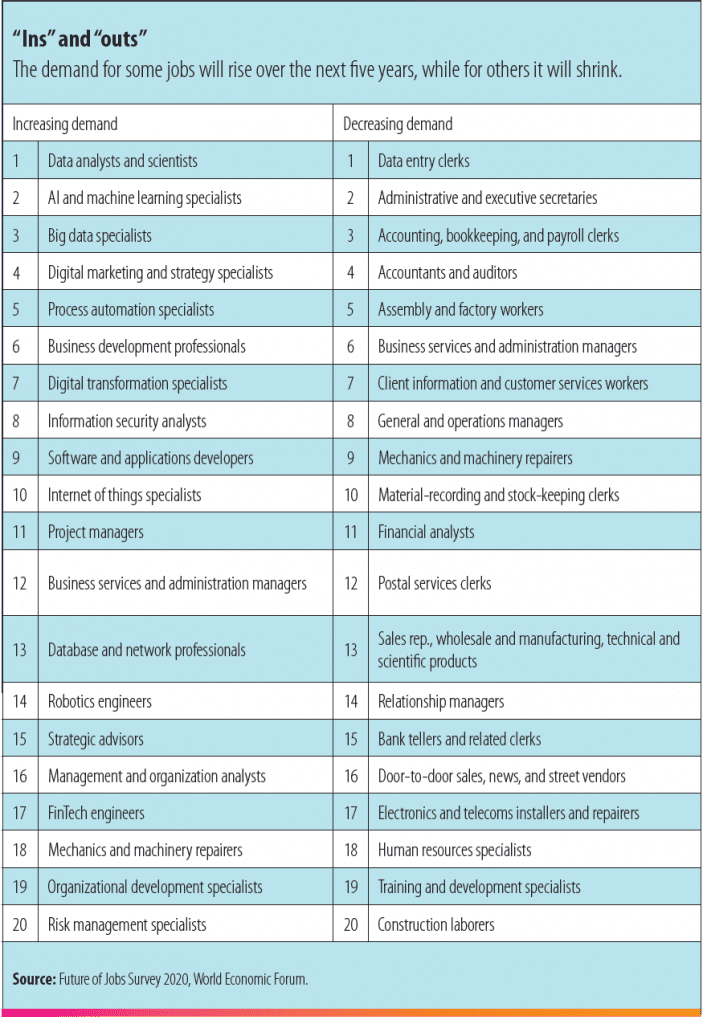
2. The robot revolution will create 97 million new jobs. As the economy and job markets evolve, new roles will emerge across the care economy in technology fields (such as artificial intelligence—AI) and in content creation careers (such as social media management and content writing). The emerging professions reflect the greater demand for green economy jobs; roles at the forefront of the data and AI economy; and new roles in engineering, cloud computing, and product development.
2. 機器人革命將創造 9700 萬個新的工作機會。 隨著經濟和就業市場的發展,照護經濟將會衍伸許多新型態的工作,例如:在科技領域中的人工智慧 (artificial intelligence, AI) 和在內容製作方面的工作,包含社群媒體管理和內容撰寫等。 新興的職業反映了這個世代對於綠色經濟的專業、數據和 AI 經濟中前線角色、以及在工程、雲端運算和產品開發中新型態職位的大量需求。
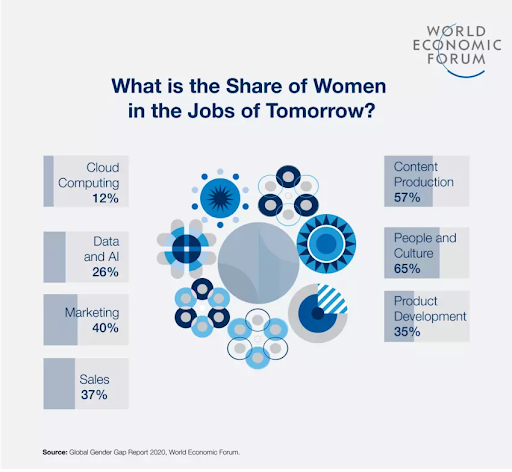
3. In 2025, analytical thinking, creativity, and flexibility will be among the most sought-after skills. Employers see critical thinking, analysis, and problem-solving as growing in importance in the coming years, although these have consistently been cited in previous editions of the survey. Newly emerging this year are skills in self-management, such as active learning, resilience, stress tolerance, and flexibility.
3. 在2025年,分析思維、創造力和靈活性將成為最受歡迎的技能之一。 即使在過往的調查中皆有呈現此結論,但企業主認為在未來幾年中,批判性思考、分析和解決的問題能力仍將越來越重要。 而今年新興的技能是「自我管理」,例如:主動學習、韌性、耐壓力和靈活性。
|延伸閱讀|變動趨勢中,策略性定位國際領導力—國際獵頭 SANDY 蘇盈如
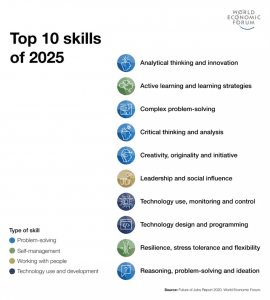
4. The most competitive businesses will focus on upgrading their workers’ skills. For workers set to remain in their roles over the next five years, nearly half will need retraining for their core skills.
4. 具高度競爭力的企業將專注於提升員工技能。對於接下來五年這些崗位上的員工,多半需要重新進行核心技能的職業訓練。
5. Remote work is here to stay. Some 84 percent of employers are set to rapidly digitalize work processes, including a significant expansion of remote working. Employers say there is the potential to move 44 percent of their workforce to operate remotely. However, 78 percent of business leaders expect some negative impact on worker productivity, and many businesses are taking steps to help their employees adapt.
5. 遠距工作是長久之策。84%的僱主已經如火如荼的開始數位化他們工作的程序,包含大幅擴大遠距工作的比例。許多僱主表示,未來預計很可能將44%的人力配置以遠距的方式進行。 但有78%的企業領導人認為,這對於員工生產效率可能會有一些負面的影響,許多企業正在著手如何協助員工適應。
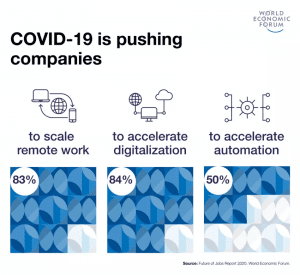
Ten defining moments for women in 2020
When talking about 2020, only the pandemic comes to our mind. But the UNWOMEN.ORG tried to look at the past year through the lens of positive momentum that happens for women’s rights and gender equality.
2020年 女性的十個重大時刻
談到2020這年,腦海裡第一個浮現的是全球的疫情。但聯合國婦女署(UN Women)試著以正面的視角看待過去的這一年—女性權益以及性別平權的發展。
《Extract from unwomen.org》
- Women leaders shine in the face of COVID-19.
- The US elects first woman vice-president.
- Scotland makes period products free for all.
- World leaders reignite the vision of the Beijing Platform for Action.
- Kuwait’s domestic violence law signals hope for women.
- TIME’s first Kid of the Year celebrates girl power and women in science
- New Zealand appoints the first indigenous woman Foreign Minister.
- Two women take home the Nobel Prize in Chemistry.
- Equal pay for women footballers in Brazil and Sierra Leone.
《節錄自 聯合國婦女署(UN Women)》
- 女性領導者在疫情前大放異彩。
- 美國選出第一個女副總統。
- 蘇格蘭免費供應生理用品。
- 世界各國領導人重申了《北京行動綱領》的願景。
- 科威特《家暴法》對女性帶來希望。
- 時代雜誌首位年度風雲兒童讚揚了女孩與科技領域的女性。
- 紐西蘭第一位原住民女性受任命為外交部長。
- 兩位女性獲得諾貝爾化學獎。
- 巴西以及塞拉利昂的女性足球員得到同工同酬的待遇。

Kamala Harris (resource: The White House, https://www.whitehouse.gov/administration/vice-president-harris/)
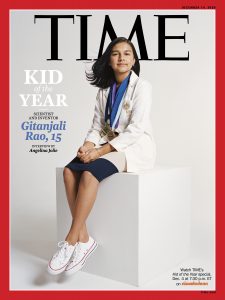
Fifteen-year-old scientist and inventor, Gitanjali Rao (resource: Time Magazine, https://www.whitehouse.gov/administration/vice-president-harris/)
The Future of Work is Flexibility
Flexible and remote working has been a game-changer in 2020. Teleworking was previously negatively perceived in many work cultures and was always more the exception than the norm. However the pandemic has forced companies to rethink the way we work to communicate. How are companies embracing trust, freedom, and new leadership styles to ensure flexible working is viable, inclusive and here to stay?
「彈性」是工作的未來趨勢
「彈性」以及「遠距工作」改變了2020年的工作規則。遠端工作過去在許多企業文化中是負面的,遠端工作多屬例外,而非常態。然而疫情迫使企業重新思考內部彼此的溝通方式。這些企業又要如何信任彼此、給予自由,並且以新的領導方式來確保有彈性的工作模式是可行的、包容的,而且可以長久施行?
《Extract from weforum.org and nytimes.com》
- “[…] almost half (48%) of the US employees surveyed by communications consultancy the Grossman Group said they wanted to continue working from home after the pandemic – and that the shift to remote work had positively impacted on their view of the company.”
- “Employees have understood what’s expected of them working from home – and been able to achieve it, says Dr Michael Ilgner, Global Head of Human Resources at Deutsche Bank: “So people perceive themselves as being very effective.”
- Client pitches have proved more successful, because the acceptance of virtual pitching has opened up opportunities to bring in the right people to front them.
- Communication is more efficient and more inclusive.
- Hierarchies are being flattened – Working from home has busted established hierarchies and silos, making us more efficient, believes Sigve Brekke, President & CEO at telecommunications company Telenor Group.
- The office space is evolving into a collaboration and innovation hub.
- This will require the right kind of planning – Enabling the best – and safest use – of office space will require an additional layer of planning to make sure the right people are there at the right time.
- And managers will need to cater for different groups’ needs.
- We’ll see new styles of leadership emerge as ‘presenteeism’ fades.
《節錄自 weforum.org 以及 nytimes.com》
- 根據通訊諮詢公司格羅斯曼集團(Grossman Group)調查,有將近半數(48%)的美國員工表示,在疫情之後他們還是想維持遠距工作(WFH),而遠距工作的調整讓他們對公司的觀感有正面影響。
- 德意志銀行全球人資主管 Michael Ilgner 表示,員工已經了解他們遠距工作所背負的期待是什麼,也有能力可以達成,因此人們會覺得自己是高效能的。
- 客戶推銷已經被證明是更成功的,因為採納線上的虛擬推銷創造了機會,可以因此吸引到合適的領導人來帶領他們。
- 溝通變得更有效而且包容。
- 組織層級變得扁平化。電信公司 Telenor 集團總裁兼執行長 Sigve Brekke 認為,遠距工作打破原本所建構的階級,讓我們變得更高效率。
- 辦公室演變為協作跟創新的場域。
- 這會需要正確的策劃-最佳、最安全的運用辦公空間需要另一個層級的規劃,以確保誰該在什麼時間使用辦公室。
- 管理者需要滿足到不同族群的需求。
- 隨著假性出席(presenteeism)的情形逐漸減少,新型態的領導方式會隨之出現。
- Headquarters aren’t going away, but more companies will embrace the hub-and-spoke model: smaller footprints in big, expensive cities, and smaller offices in places where employees want to (and can afford to) live.
- “I think the future is actually having to manage people,” said Adam Segal, the chief executive of Cove, which helps companies organize shared desk and conference space.“The default setting right now is that you just see people in the office, and that’s how you manage them. But now people actually have to learn how to communicate about the work that you’re doing, about productivity, about expectations.”
- Post-Covid flexibility is going to make the office even better. Workers are going to have a higher quality of life, more time with their kids, more connection to their communities.
- 公司的營運總部不會消失,但會採用輻射式的模式(hub-and-spoke model)設置小型辦公室-在租金昂貴的大城市中佔地面積小,而且位在員工想居住、生活也負擔的起的地方。
- 未來是必須去管理「人」, Cove 公司(協助企業共享辦公環境與會議室)執行長 Adam Segal 表示,「現在一般的管理方式是,你看的到員工在辦公室裡,這就是管理。但現在必須要學習的是,針對你正在進行的工作、生產內容,還有你所期望的進行溝通。」
- 後疫情的彈性會讓辦公變得更好。員工會有更優良的生活品質、可以花更多時間在孩子身上,也會跟周遭的群體有更多連結。









